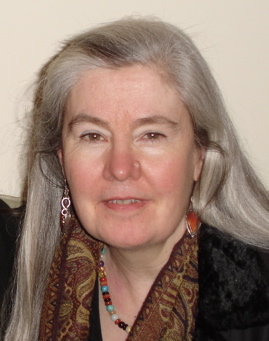
Dr. Maureen Jackson, the UW Cole Fellow in 2008-09, returns on Feb. 10th for a special book event and musical performance.
Q. (Hannah Pressman) Welcome back to Seattle! What have you been up to since your year as the Hazel D. Cole Fellow at UW (2008-09)?
A. (Maureen Jackson) After my Hazel Cole Fellowship I went to Turkey for a year of post-doctoral research. My field site was Izmir, a port city on the Mediterranean where there was a vibrant music and entertainment scene at the turn of the 20th century, in which Jewish musicians played an important part before a major war-related fire destroyed much of the city. I received an ACLS New Faculty Fellowship, which took me to Carleton College in Minnesota for two years where I taught courses in Ottoman and Sephardic cultural history and completed my book, Mixing Musics. In 2013-14 I was honored to receive a Harry Starr Fellowship at Harvard University, where I joined five ethnomusicologists and music historians focusing on the theme of music in Jewish life.
Q. Congratulations on your new book, Mixing Musics: Turkish Jewry and the Urban Landscape of a Sacred Song (Stanford University Press), winner of the 2013 National Jewish Book Award in Sephardic Culture! Was there a particular song or text that inspired you to pursue the fascinating topic of multiethnic music in Turkey?
A. Over time a number of special experiences crystallized to inspire me to study multiethnic music in Turkey. Music has always been a central part of my life since childhood. In 2000, as a graduate student at the U of Washington focusing on Turkish studies, I joined an Ottoman and Turkish music ensemble, led by Münir Beken, a visiting artist in Ethnomusicology. I became curious about and fascinated by the Ottoman musical heritage in the Turkish Jewish immigrant community in Seattle. For Münir Beken’s Ottoman music course I did research among Sephardic community members and in the Sephardic archives in Suzzallo Library. I still remember consulting with Münir in his office about my final project for the course – out of 2 or 3 topics related to Ottoman music, he encouraged me to do the local, ethnographic one that would take me out of the library and into the community, because that “would be a bit more interesting.” It can be simple words and encounters in education that contribute to opening new paths for learning and inspiring a new course of study.
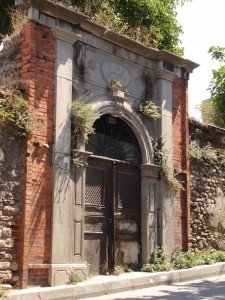
Garden gate of Kasturiya synagogue, Istanbul. Reproduced by permission from the collection of Maureen Jackson.
In my research I focus in particular on the social history of the music – how Ottoman and Turkish Jewish music and musicians were embedded in the ambient urban life in its social, economic, and political dimensions. A number of faculty members and graduate courses at the UW inspired my historical approach, including an original year-long seminar, “Re-envisioning the Ottoman Empire,” designed and taught by Reşat Kasaba, Sarah Abrevaya Stein, and Selim Kuru, in addition to theoretical courses with Ramonda Modiano in her innovative Textual Studies program. For my doctoral research I spent a year in Istanbul (2005-6) focusing on Jewish religious music within its wider cultural context. The specific topic of my dissertation, book, and the upcoming program at the UW on February 10th is a vocal repertoire, the Maftirim – a sacred suite of songs with fascinating musical and social interconnections with the Ottoman court suite performed and cultivated in the Sultan’s palace.
Q. Is preservation of endangered musical traditions one of your goals as a scholar? What kind of resources or tools are necessary to ensure that Ottoman-era Jewish music, or similar disappearing traditions, can be studied and enjoyed by future generations?
A. A recent publication by the Istanbul Jewish community, Maftirim (Istanbul, 2009), makes available archival recordings of these religious songs, as well as Hebrew lyrics, notation, and translations into Turkish, Ladino, and English. It is a tremendously valuable project that documents over 60 Maftirim songs sung by those considered to be the last three masters of the music. If you look at the labor-intensive process involved in publishing these songs, you can appreciate the kind of resources needed for such high-quality productions – knowledgeable musicians, music historians, notators, translators, among others, not to mention state-of-the-art remastering technology for the recordings. I think it was the will, knowledge, motivation, and funding among Jewish and non-Jewish musicians alike in Istanbul that spurred and sustained this effort. An individual can carry out such demanding work, but institutions, in this case the Ottoman-Turkish Sephardic Culture Research Center, directed by a musician, Karen Gerson Şarhon, can often provide much-needed funding and sustained support.
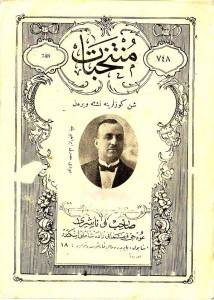
Musical score of a composition by Udi Mısırlı İbrahim Efendi (original
name Avram Levi, 1879-1948). Reproduced by permission from the
collection of Mehmet Güntekin.
For example, Ottoman and Turkish Jewish religious composers are generally only known or studied within the Istanbul Jewish community, because they only composed Hebrew language pieces and performed exclusively in the synagogue. As in the case of Hayim Bejerano, the first Chief Rabbi of the Turkish Republic and a composer himself, such musicians were hardly isolated within an ethno-religious practice or sphere, but in fact lived at the center of – and were central to – a far-reaching Ottoman and Turkish music world.
I am also interested in how individuals and communities think about cultural preservation, because there can be different answers to questions of what, why, and how to preserve, as well as different ideas about is ‘authentic’ and what constitutes ‘tradition.’ In the final chapter of my book I look closely at the recent Maftirim publication in light of these questions. What is interesting about Maftirim and Ottoman music in general is that musicians learned pieces orally without notation from master musicians, so there may be several different extant versions of a single piece. The publication provides listeners with certain musical versions and not others, so aims to preserve what is actually a fluid tradition.
Q. Your book event on Feb. 10, “Mixing Musics: The Sacred Songs of Istanbul Jews,” is going to feature a musical performance by Münir Beken, an ud soloist and ethnomusicologist at UCLA. Have you presented your work alongside a musical performance before?
A. Our program at UW is our world premiere! I was inspired to invite composer, musicologist, and ud-player Münir Beken to join me for this lecture-demonstration in order to bring to life the musical ambience of Ottoman and Turkish music that forms the foundation of the religious music of Istanbul’s Jews in general and the Maftirim repertoire in particular. In the course of the evening relevant musical interludes will complement the historical journey we will take as we explore Maftirim music in its wider social environment. Münir has a depth of knowledge about Ottoman, Turkish, European and global musics that is unmatched among musicians in either the United States or Turkey today. Studying from an early age with musical masters in the Ottoman-Turkish tradition, he is uniquely positioned to express the music at the heart of my study. In addition, he has conducted research on the now vanishing gazinos (nightclubs) in Istanbul where Turkish classical suites were performed. Interestingly, our informants – gazino musicians and Jewish cantors respectively – share similar stories, sentiments, and strategies regarding the musical losses they have experienced in the last few decades. This is a contemporary example of ‘mixing musics’ – the engagement of Turkish Jewish religious musicians with the ambient musical culture of radio, records, film, and entertainment venues in 20th-century Turkey.
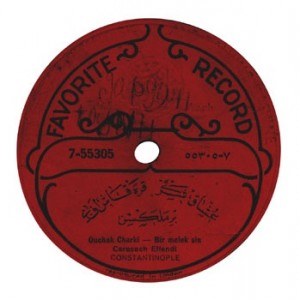
Vocalist Avram Karakaş (active 1890-1914) on Favorite Record, an early 20th century recording company in Istanbul. Reproduced by permission
from the collection of Mehmet Güntekin.
Q. Is the February 10th event at UW primarily a book reading with musical accompaniment? What do you hope people in the audience will gain?
A. The event is not a book reading, even though my book will be available at a discount to attendees. The program, I hope, will not only to bring to life the important themes and musical dimensions of the study, but also convey aspects of my research that ended up on the cutting room floor, as it were. For example, countless personal stories – brief encounters, coincidences, mishaps – occurred in the course of ethnographic research in Istanbul that, however important to my findings, remain outside the purview of a book. Among other areas, I hope to include this vital, but often invisible, dimension of my research.
Q. I have to ask: do you have another project on the horizon, and can you tell us about it?
I am currently working on my Izmir research project, which I am conceiving of as a second book. I am also very pleased to be invited to contribute an article, based on my book, to a special issue on music in a Turkish academic journal, Toplumsal Tarih (Social History), published in Istanbul. This is an exciting opportunity to share my work in Turkish with new audiences beyond the English-speaking academy and publics.
Editor’s note: The cover image for this story on our homepage shows Udi Mısırlı İbrahim Efendi (in the circle) in the Türk Gülşen music ensemble, Istanbul. It is reproduced by permission from Gözlem Gazetecilik Basın ve Yayın, Istanbul.
Click here for details and advance registration for the Feb. 10th celebration of “Mixing Musics.”



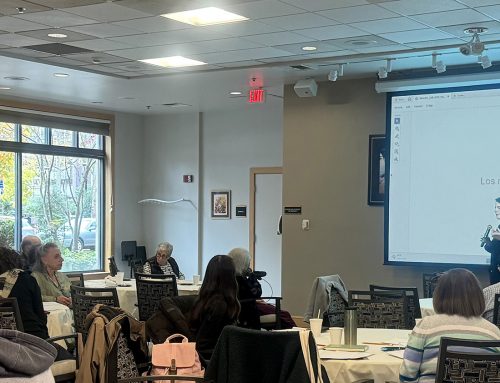


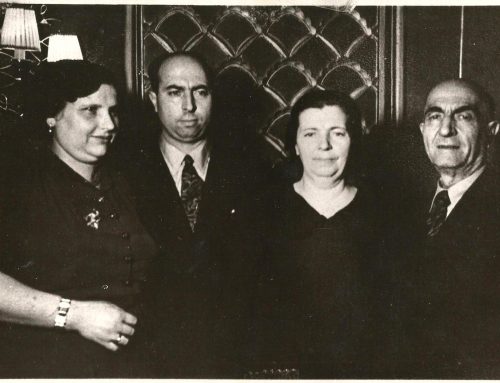
Leave A Comment